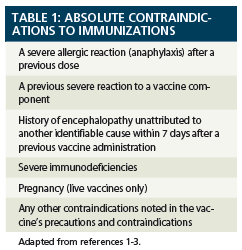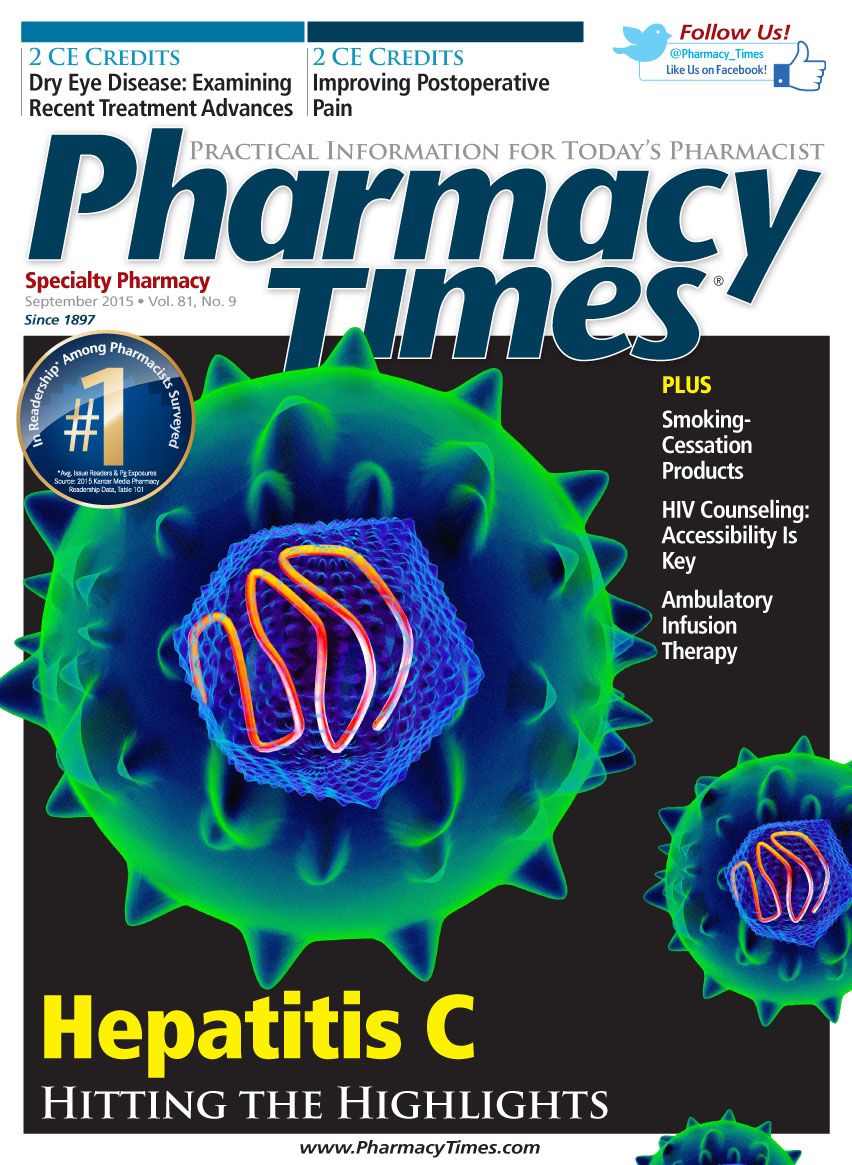Publication
Article
Pharmacy Times
Immunization in a Nonhospital Setting: Managing Adverse Events
Author(s):
Widespread vaccine use benefits the public by producing unprecedented good health. Vaccine-related adverse events, which can be perceived or real, can decrease vaccination rates, however.

Widespread vaccine use benefits the public by producing unprecedented good health. Vaccine-related adverse events (AEs), which can be perceived or real, can decrease vaccination rates, however. Therefore, immunizers who screen patients carefully—acknowledging labels’ precautions and contraindications before administering vaccines (Table 11-3)—minimize the likelihood of AEs and boost the public’s trust.
Reaction Types
Stringent regulatory standards and continuous product testing and monitoring situate vaccines among the safest pharmaceuticals.4 Vaccine pharmacovigilance data tell us 5 general types of immunization reactions occur (Table 22,4,5,8-11). Pharmacists should note that coincidental events sometimes occur, but are mistakenly attributed to a vaccination; for example, genetic conditions or unrecognized injuries acquired before, during, or after birth may first become apparent around the time of a vaccination. Some parents, looking for a cause, will blame the vaccination.1,5 When discussing vaccines with patients, health care providers need to describe the associated risks and balance that discussion with the risks associated with refusing a vaccination.6 The discussion should also include points about individual versus societal benefits (eg, herd immunity).7
One local reaction is more than trivial or inconvenient. Nicolau syndrome, a rare, localized site reaction, can follow any intramuscular injection. Pain develops quickly, followed by swelling, a bluish discoloration, and hemorrhagic patches. This reaction can progress to cutaneous and soft tissue necrosis. Immediate referral to a dermatologist is critical. Pentoxifylline, heparin, or hyperbaric oxygen may improve local circulation. Intralesional corticosteroids may decrease inflammation.9
Serious AEs are rare, occurring in far less than 1% of people. Coincidental AEs, including death, that may occur around the time of administration may be temporarily associated with the vaccination, as previously mentioned.1 The Institute of Medicine reports that the majority of deaths reported near administration were not caused by the vaccine; the timing made them appear coincidental.12 Continuous monitoring by staff at the Vaccine Adverse Event Reporting System confirms this finding.13
Emergency Response
If the injection site itches or swells immediately after vaccination, observe the patient closely for generalized symptoms. If these develop, call 911 and have someone stay with the patient until the ambulance arrives. In addition:
- Administer a dose of aqueous epinephrine 1:1000 dilution intramuscularly, 0.01 mL/kg. Adult doses range from 0.3 mL to 0.5 mL, with a maximum single dose of 0.5 mL. Perform CPR, if necessary, and maintain the patient’s airway. Repeat the epinephrine dose every 10 to 20 minutes for up to 3 doses, noting the dose, time, and patient’s response for emergency medical personnel when they arrive.
- Monitor blood pressure and pulse every 5 minutes. Ask the patient to lie flat on his or her back. If the patient’s breathing is labored and blood pressure is adequate, elevate the patient’s head. If the patient’s blood pressure is low, elevate the legs.
- Once the patient is en route to the hospital, notify the patient’s primary care physician and provide all information related to the incident. Also, update the patient’s medication profile.14
To prepare for an emergency response like the one above, pharmacies should hold emergency drills regularly to prepare staff. Additionally, every immunizer needs to know about immunize.org, which has a chart describing adverse reaction management at www.immunize.org/ catg.d/p3082.pdf. This is a useful resource for pharmacies because it provides the protocol described above in a detailed, visual format.14
End Note
The decision to vaccinate—or not—is influenced by patients’ understanding of a vaccination and the disease it prevents, as well as by patients’ bias and emotions.15 Some research indicates that providing a balanced explanation of risks and benefits and listening carefully to patient concerns can discredit background anti-vaccination messages. Accumulating evidence suggests there are genetic determinants of AEs from vaccines. For example, with the MMR vaccine, febrile seizures occur in 3 to 16 children per 10,000 immunized patients. This AE has been associated with specific chromosome/single nucleotide polymorphism on key immunoreceptor genes. In the future, personalized medicine in vaccinology—called adversomics— will screen for this genetic variation.3,18
Acknowledge that vaccines, like all medical interventions, are not 100% safe and effective. Respect patients’ opinions, and always provide accurate, understandable evidence. Address patient concerns, including potential pain and discomfort.8,16,17 For now, individuals are more likely to be seriously or fatally injured by vaccine-preventable diseases than by the vaccines designed to prevent them.12
Table 2: Immunization Reactions: Telltale Signs and Tips
Reaction Type
Telltales and Tips
Localized
· Often presents with itching, soreness, or pain at the injection site
· Usually described as trivial or inconvenient
· If bleeding occurs, apply firm pressure with gauze
· Analgesics, cold compresses, and antipruritics relieve pain and increase comfort
Immunization anxiety—related reaction
· Psychological fright and syncope (twitching during a syncopal episode
is sometimes interpreted as seizure activity by observers)
· Patients who have had this type of reaction previously should sit or
recline before and during vaccination
· If faintness or fainting occurs, have patients lie flat or sit with their head
between their knees for several minutes, loosen tight clothing and
maintain an open airway, and cool their faces and necks with damp
cloths
Systemic
· Neurologic events, including febrile seizures, meningitis, encephalitis,
and brachial neuritis, have been reported very rarely; these generally
occur 6 days to 3 weeks after vaccination
· Risk increases in children with an immunodeficiency
· Rare, erythema multiforme is an acute, usually self-limiting, immune-
mediated reaction characterized by target-like lesions
· Stevens-Johnson syndrome is possible, but rare
Allergic
· Rare and difficult to predict
· Believed to be overdiagnosed
· Usually related to egg, milk, antibiotic, or vaccine component allergy
· Affects the cutaneous, respiratory, cardiovascular, and gastrointestinal
systems
· Children may present with respiratory symptoms followed by cutaneous
symptoms
· Egg sensitivity is not an absolute contraindication to influenza vaccine;
consult current guidelines
Anaphylaxis
· Rare; when it occurs, activate an emergency response
· Sudden or gradual onset of generalized itching, erythema, or hives;
swelling of the lips, face, or throat; severe bronchospasm; shortness of
breath; shock; abdominal cramping; or cardiovascular collapse
Adapted from references 2, 4, 5, and 8-11.
Ms. Wick is a visiting professor at the University of Connecticut School of Pharmacy and a certified immunizer.
References
- Miller ER, Moro PL, Cano M, Shimabukuro TT. Deaths following vaccination: what does the evidence show? Vaccine. 2015;33(29):3288-3292. doi: 10.1016/j.vaccine.2015.05.023.
- Shaffer C, Aymong L. Administering vaccines. Nursing. 2014;44(10):46-50. doi: 10.1097/01.NURSE.0000452997.64406.b6.
- Pasternak B, Feenstra B, Melbye M, Hviid A. Improving vaccine safety through a better understanding of vaccine adverse events. Clin Infect Dis. 2015;60(10):1586-1587. doi: 10.1093/cid/civ080.
- Dellepiane N, Griffiths E, Milstien JB. New challenges in assuring vaccine quality. Bull World Health Organ. 2000;78(2):155-162.
- Law B. Neurological adverse events after vaccination. Encyclopedia on Early Childhood Development website. www.child-encyclopedia.com/Pages/PDF/LawANGxp1.pdf. Published April 2013. Accessed June 15, 2015.
- Larson H, Brocard Paterson P, Erondu N. The globalization of risk and risk perception: why we need a new model of risk communication for vaccines. Drug Saf. 2012;35(11):1053-1059. doi: 10.2165/11635880-000000000-00000.
- Oubari H, Tuttle R, Rath B, Bravo L. Communicating vaccine safety to the media and general public. Curr Drug Saf. 2015;10(1):80-86.
- MacDonald NE, Smith J, Appleton M. Risk perception, risk management and safety assessment: what can governments do to increase public confidence in their vaccine system? Biologicals. 2012;40(5):384-388. doi: 10.1016/j.biologicals.2011.08.001.
- Rosenblatt AE, Stein SL. Cutaneous reactions to vaccinations. Clin Dermatol. 2015;33(3):327-332. doi: 10.1016/j.clindermatol.2014.12.009.
- Hasan SA, Wells RD, Davis CM. Egg hypersensitivity in review. Allergy Asthma Proc. 2013;34(1):26-32. doi: 10.2500/aap.2013.34.3621.
- Caubet JC, Ponvert C. Vaccine allergy. Immunol Allergy Clin North Am. 2014;34(3):597-613, ix. doi: 10.1016/j.iac.2014.04.004
- Institute of Medicine. In: Stratton KR, How CJ, Johnston RB, eds. Adverse Events Associated With Childhood Vaccines: Evidence Bearing On Causality. Washington, DC: National Academies Press; 1994.
- Moro PL, Arana J, Cano M, Lewis P, Shimabukuro TT. Deaths reported to the Vaccine Adverse Event Reporting System, United States, 1997-2013. Clin Infect Dis. 2015. pii: civ423.
- Medical management of vaccine reactions in adult patients. Immunization Action Coalition website. www.immunize.org/catg.d/p3082.pdf. Published September 2014. Accessed June 15, 2015.
- Bouder F. Risk communication of vaccines: challenges in the post-trust environment. Curr Drug Saf. 2015;10(1):9-15.
- Austvoll-Dahlgren A, Helseth S. What informs parents’ decision-making about childhood vaccinations? J Adv Nurs. 2010;66(11):2421-2430. doi: 10.1111/j.1365-2648.2010.05403.x.
- Luthy KE, Beckstrand RL, Callister LC. Parental hesitation in immunizing children in Utah. Public Health Nurs. 2010;27(1):25-31. doi: 10.1111/j.1525-1446.2009.00823.x.
- Whitaker JA, Ovsyannikova IG, Poland GA. Adversomics: a new paradigm for vaccine safety and design. Expert Rev Vaccines. 2015;14(7):935-947. doi: 10.1586/14760584.2015.1038249.







